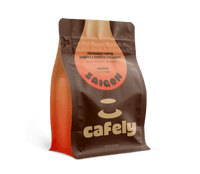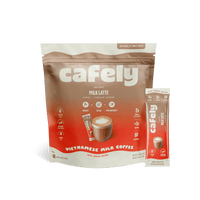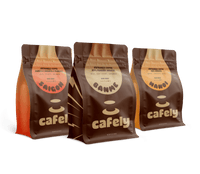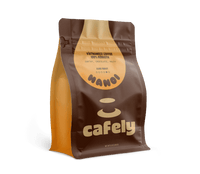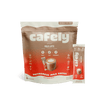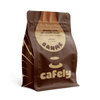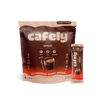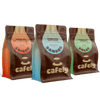Red eye coffee is just what you need if you’ve had a bad night’s sleep and need to get through a long, busy day. It’s made from a drip coffee that’s been supercharged with a shot of espresso.
All that caffeine is guaranteed to keep you energized all day long!
In this article, we’ll cover where red eye coffee comes from, how to make it yourself at home, and the surprising health benefits it offers.
Red Eye Coffee Origin
Red eye coffee comes from overnight flights with the same name. In the 1960s, Americans who traveled for business and needed to get from one side of the country to the other would fly on a red-eye flight. This type of flight departed at night and landed first thing in the morning.
These flights were uncomfortable, and travelers would struggle to sleep. To help ease fatigue, air stewardesses served a unique type of coffee made from drip coffee with a shot of espresso. This was offered to passengers for free on all red eye flights.
After a sleepless night, passengers would land at their destination with red eyes, and the name "red eye coffee" was born.
Caffeine Content of Red Eye Coffee

With the combination of a drip coffee and an espresso shot, the caffeine content is pretty high in a red eye coffee. A shot of espresso contains around 75 mg of caffeine. A regular 8 oz drip coffee contains 80-100 mg of caffeine. Add them together, and you're looking at up to 175 mg of caffeine in a single red eye coffee.
For reference, the USDA and the EFSA both state you shouldn’t have more than 400 mg of caffeine in a day.
How to Make Red Eye Coffee at Home
Making a red eye coffee at home is a relatively straightforward process. You’re going to need your standard drip coffee maker and something to pull a shot of espresso with.
Using your drip coffee maker, brew your coffee as normal using a 1:2 coffee-to-water ratio. If you need help using your drip machine, take a look at our handy brew guide.
Set your coffee aside while you prepare your espresso machine. In most coffee shops, they pull a double shot of espresso as standard for a red eye coffee.
But at home, you can choose between a single or double shot. Brew your espresso as normal using your espresso machine.
Once you’ve pulled your shot of espresso, simply pour it into your drip coffee. Enjoy immediately!
Red Eye Coffee: Simple Step-By-Step Instructions
- Warm up your espresso machine.
- Put a fresh filter in your drip machine.
- Add water to your drip machine.
- Measure and grind coffee for both your espresso machine and drip coffee maker.
- Place the ground coffee in both coffee machines.
- Prepare and tamp your portafilter for the espresso.
- Start your drip coffee maker.
- Brew your espresso.
- Combine the two.
A red eye may be more bitter than your standard coffee. So you may need to add more sugar or milk than normal if you don’t want to drink it straight-up.
Benefits of Drinking Red Eye Coffee
There are a lot of potential health benefits that come with having a caffeine hit in your daily coffee. In addition to the short-term boosts to your mood [1], focus [2], and metabolism [3], caffeine also has wide-reaching, long-term health benefits.
These include:
- Lowering the risk of heart disease [4]
- Reducing the risk of stroke [5]
- Protecting against diabetes [6]
- Lowering the risk of liver damage [7]
- Decreasing the chance of premature death [8]
- Reducing the risk of cancer [9]
- Preventing gout [10]
- Boosting beneficial gut bacteria [11]
Compared with regular coffee, red eye coffee’s increased caffeine levels will heighten a lot of these benefits, especially the short-term ones. However, it’s important to consider the wider health implications of having too much caffeine.
Too much caffeine (over 400 mg per day) can:
- Worsen the symptoms of anxiety
- Lead to lower bone density
- Affect your blood sugar [12]
- Contribute to your chances of stroke and dementia [13]
As with any coffee with a high caffeine content, it’s best to drink a red eye coffee in the morning. This means it has less chance of affecting your sleep schedule later in the day.
Popular Variations of Red Eye Coffee
The standard red eye coffee is made by adding a single espresso shot to a cup of drip coffee. But there are several variations available if you're looking to mix things up.
Popular variations include:
- The Black Eye Coffee — A drip coffee with a double shot of espresso.
- The Dead Eye Coffee — A drip coffee with a triple shot of espresso.
- The Green Eye Coffee — The Starbucks version of a Dead Eye. It still has three shots of espresso over a drip coffee; it’s just the Starbucks name for it.
- The Lazy Eye Coffee — Take two or three shots of espresso and top it off with decaf coffee.
The more espresso you add, the richer and more bitter the coffee becomes. The caffeine content also scales up, adding around an extra 75 mg of caffeine per shot.
Espresso has a rich flavor profile and a bitter depth to it that enhances the flavor of the drip coffee. The more espresso you add, the more complex the flavor becomes.
Keep in mind that a triple shot of espresso contains 210 mg of caffeine. When you add this to the 90 mg of caffeine in a drip coffee, a dead eye coffee is almost your maximum daily caffeine allowance in a single sitting.
You can customize your super strong coffee any way you like. Some people like to boost their red eye even further with copious amounts of sugar, while some like a splash of milk to take the bitter edge off the brew.
Red Eye Coffee vs. Other Espresso-Based Drinks
How does red eye coffee stack up to other espresso-based drinks? Here’s a table that shows you how they compare:

Pairing Red Eye Coffee with Foods
With such a strong and bitter coffee, sweet breakfast foods are the best things to pair with red eye coffee. Many people opt for maple-glazed donuts, blueberry muffins, or coffee cake recipes to balance the flavors.
As espresso has chocolate notes, it makes sense to go with sweeter flavors that complement the coffee and counteract the bitter aftertaste. Something sweet will also give you a sugar jolt to enhance the caffeine boost.
Red eye is traditionally a morning coffee due to its strength, so a lot of the time, you’ll be pairing it with breakfast foods. If you’re on the go or looking for a snack to go with your red eye coffee, peanut butter flavors work well thanks to the salty-sweet element.
Grab a peanut or almond butter protein ball from your local coffee shop for a quick pairing.
Hosting a Red Eye Coffee Tasting
If you’re hosting a coffee tasting featuring red eye coffee, we’d recommend going with a medium roast like our DaNang blend of arabica and robusta. If you go too dark with the roast, you risk the red eye becoming far too bitter and unbalanced.
If this is your first time making red eye coffee start with a lighter roast or 100% arabica brew like our DaLat coffee. It will give you a flavor boost without the additional hit of caffeine you get in robusta coffee beans.
Make sure you have plenty of water, sugary snacks, and a relatively cool room to do your tasting. With the high caffeine content, the coffee jitters may appear which can make people feel heart palpitations, dehydrated, light-headed, and overly warm.
FAQs: Red Eye Coffee
Now you know all about red eye coffee and how to make it at home, let’s finish things off with some frequently asked questions.
1. What is the caffeine content in a typical red eye coffee?
The caffeine content of a classic red eye is about 158 mg. The exact caffeine content varies depending on the type of beans you use and how many espresso shots you add to the drip coffee. Take note that a single shot of espresso contains an average caffeine content of 75mg.
2. Can red eye coffee be made iced?
Yes, a red eye coffee can be made iced. This is a refreshing alternative that still packs a punch, perfect for those hot summer days.
3. Is red eye coffee suitable for all coffee drinkers?
No, red eye coffee is not suitable for all coffee drinkers. Due to its high caffeine content, it may not be suitable for those with caffeine sensitivities or those who get anxious after a couple of regular cups of coffee. If you’re unsure, ask your doctor or health professional.
4. How does red eye coffee compare to an Americano?

Unlike the classic Americano coffee, red eye uses drip coffee instead of hot water, offering a richer flavor and stronger caffeine kick. It's two coffees in one cup, which is why it's so strong. Americanos, on the other hand, are just espressos topped with hot water.
5. Can I customize my red eye coffee at home?
Yes, you can customize your red eye coffee at home. You can try making it with different coffee beans, adding extra espresso shots, using flavored syrups, and pouring in different kinds of milk to mix it up.
6. What is the best time to drink red eye coffee?
The best time to drink coffee, especially red eye coffee is during early mornings or when an extra boost of energy is needed. You shouldn’t have a red eye coffee in the afternoon as it can mess with your sleep schedule and quality.
7. How does red eye coffee taste?
Red eye coffee has a robust flavor with a balance of sweetness from drip coffee and bitterness from espresso. The more espressos you add to the mix, the more bitter and rich in flavor the brew becomes.
8. Are there decaffeinated versions of red eye coffee?
Yes, there is a decaffeinated version of a red eye coffee. It’s called a "lazy eye" and uses decaffeinated beans for those who prefer less caffeine. The flavor is still strong and punchy, but it won’t keep you up at night like a traditional red eye.
9. What equipment do I need to make red eye coffee?
The equipment you need to make a red eye coffee includes a drip coffee maker and an espresso machine or a substitute like a Moka pot.
10. Where did red eye coffee originate?
The red eye coffee originated in the United States following the need for strong coffee during red-eye flights. It became popular in the 90s in the coffee shops of New York, where people would get off their long-haul flights from the West Coast to go to business meetings. It's also been known as a "shot in the dark" and "coffee with a shot."
References
- Fredholm, B. B. (1995). Adenosine, adenosine receptors, and the actions of caffeine. Pharmacology & Toxicology, 76(2), 93-101.
- Heckman, M. A., Weil, J., & De Mejia, E. G. (2010). Caffeine (1, 3, 7‐trimethylxanthine) in foods: a comprehensive review on consumption, functionality, safety, and regulatory matters. Journal of Food Science, 75(3), R77-R87.
- Acheson, K. J., Zahorska-Markiewicz, B., Pittet, P., Anantharaman, K., & Jéquier, E. (1980). Caffeine and coffee: their influence on metabolic rate and substrate utilization in normal weight and obese individuals. The American journal of clinical nutrition, 33(5), 989-997.
- Wu, J. N., Ho, S. C., Zhou, C., Ling, W. H., Chen, W. Q., Wang, C. L., & Chen, Y. M. (2009). Coffee consumption and risk of coronary heart diseases: a meta-analysis of 21 prospective cohort studies. International journal of cardiology, 137(3), 216-225.
- Larsson, S. C., & Orsini, N. (2011). Coffee consumption and risk of stroke: a dose-response meta-analysis of prospective studies. American Journal of Epidemiology, 174(9), 993-1001.
- Jiang, X., Zhang, D., & Jiang, W. (2014). Coffee and caffeine intake and incidence of type 2 diabetes mellitus: a meta-analysis of prospective studies. European journal of nutrition, 53, 25-38.
- Saab, S., Mallam, D., Cox, G. A., & Tong, M. J. (2014). Impact of coffee on liver diseases: a systematic review. Liver International, 34(4), 495-504.
- Lopez-Garcia, E., van Dam, R. M., Li, T. Y., Rodriguez-Artalejo, F., & Hu, F. B. (2008). The relationship of coffee consumption with mortality. Annals of Internal Medicine, 148(12), 904-914.
- Sang, L. X., Chang, B., Li, X. H., & Jiang, M. (2013). Consumption of coffee associated with reduced risk of liver cancer: a meta-analysis. BMC gastroenterology, 13, 1-13.
- Choi, H. K., & Curhan, G. (2010). Coffee consumption and risk of incident gout in women: the Nurses’ Health Study. The American journal of clinical nutrition, 92(4), 922-927.
- Jaquet, M., Rochat, I., Moulin, J., Cavin, C., & Bibiloni, R. (2009). Impact of coffee consumption on the gut microbiota: a human volunteer study. International journal of food microbiology, 130(2), 117-121.
- Rebelo, I., & Casal, S. (2017). Coffee: A Dietary Intervention on Type 2 Diabetes? Current Medicinal Chemistry, 24(4), 376–383.
- Abalo, R. (2021). Coffee and Caffeine Consumption for Human Health. Nutrients, 13(9), 2918.
